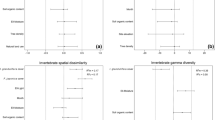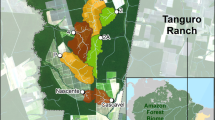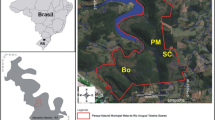Abstract
The strength of linkages between riparian plants and stream communities can be expected to be influenced by invading plants. While most studies so far have been focussed on the effects of the leaf litter quality of the invader, this study addresses the impact of detritivores on the pool of detritus. In a natural setting, we found that species richness of shredding macroinvertebrates significantly influenced the breakdown rate of an invasive weed species, the Japanese knotweed (Fallopia japonica), which has become a major plant invader along streams and rivers in Europe and North America. Our findings imply that a reduction of the diversity of shredder species, which may be the result of disturbances, could negatively influence stream ecosystems' capacity of processing knotweed leaves. Although the knotweed showed breakdown rates similar to those of common native tree and shrub species, other exotic leaf species might show considerably slower rates and hence have greater consequences for the ecosystems. We have, in this study, indicated a technique by which the effects of other non-indigenous plants on ecosystem functioning might be considered.
Similar content being viewed by others
References
Bailey JK, Schweitzer JA and Whitham TG (2001) Salt cedar negatively affects biodiversity of aquatic macroinvertebrates. Wetlands 21: 442–447
Baldy V, Gessner MO and Chauvet E (1995) Bacteria, fungi and the breakdown of leaf litter in a large river. Oikos 74: 93–102
Belnap J and Phillips SL (2001) Soil biota in an ungrazed grassland: response to annual grass (Bromus tectorum) invasion. Ecological Applications 11: 1261–1275
Boulton AJ, Scarsbrook MR, Quinn JM and Burrell GP (1997) Land-use effects on the hyporheic ecology of five small streams near Hamilton, New Zealand. New Zealand Journal of Marine and Freshwater Research 31: 609–622
Brown WT, Krasny ME and Schoch N (2001) Volunteer monitoring of nonindigenous invasive plant species in the Adirondack Park, New York, USA. Natural Areas Journal 21: 189–196
Canhoto C and Graça MAS (1995) Food value of introduced eucalypt leaves for a Mediterranean stream detritivore – Tipula lateralis. Freshwater Biology 34: 209–214
Cummins KW, Wilzbach MA, Gates DM, Perry JB and Taliaferro (1989) Shredders and riparian vegetation. Bioscience 39: 24–39
Dangles O and Guérold F (2001) Influence of shredders in mediating breakdownrates of beech leaves in circumneutral and acidic forest streams. Archiv für Hydrobiologie 151: 649–666
Dawson FH and Holland D (1999) The distribution in bankside habitats of three alien invasive plants in the UK in relation to the development of control strategies. Hydrobiologia 415: 193–201
Duncan RP and Young JR (2000) Determinants of plant extinction and rarity 145 years after European settlement of Auckland, New Zealand. Ecology 81: 3048–3061
Emmerson MC, Solan M, Emes C, Paterson DM and Raffaelli D (2001) Consistent patterns and the idiosyncratic effects of biodiversity in marine ecosystems. Nature 411: 73–77
Fruget JF (1992) Ecology of the Lower Rhone after 200 years of human influence –a review. Regulated Rivers – Research and Management 7: 233–246
Gessner MO and Chauvet E (1994) Importance of stream micro-fungi in controlling breakdown rates of leaf litter. Ecology 75: 1807–1817
Godreau V, Bornette G, Frochot B, Amoros C, Castella E, Oertli B, Chambaud F, Oberti D and Craney E (1999) Biodiversity in the floodplain of Saone: a global approach. Biodiversity and Conservation 8: 839–864
Gregory SV, Swanson FJ, McKee WA and Cummins KW (1991) An ecosystem perspective of riparian zones. Bioscience 41: 540–551
Graça MAS, Cressa C, Gessner MO, Feio MJ, Callies KA and Barrios C (2001) Food quality, feeding preferences, survival and growth of shredders from temperate and tropical streams. Freshwater Biology 46: 947–957
Heard SB and Richardson JS (1995) Shredder-collector facilitation in stream detrital food webs. Is there enough evidence? Oikos 72: 359–366
Hieber M and Gessner MO (2002) Contribution of bacteria, fungi and invertebrate shredders to leaf litter breakdown in a stream: estimates derived from biomass determinations. Ecology 83: 1026–1038
Hoffmann BD, Andersen AN and Hill GJE (1999) Impact of an introduced ant on native rain forest invertebrates: Pheidole megacephala in monsoonal Australia. Oecologia 120: 595–604
Hood WG and Naiman RJ (2000) Vulnerability of riparian zones to invasion by exotic vascular plants. Plant Ecology 148: 105–114.
Huston MA (1997) Hidden treatments in ecological experiments: re-evaluating the ecosystem function of biodiversity. Oecologia 110: 449–460
Jonsson M and Malmqvist B (2000) Ecosystem process rate increases with animal species richness: evidence from leaf-eating, aquatic insects. Oikos 89: 519–523
Jonsson M, Dangles O, Malmqvist B and Guérold F (2002) Simulating species loss following disturbance: assessing the effect on process rate. Proceedings of the Royal Society of London 269: 1047–1052
Levine JM and D'Antonio CM (1999) Elton revisited: a review of evidence linking diversity and invasibility. Oikos 87: 15–26
Lyons KG and Schwartz MW (2001) Rare species loss alters ecosystem function – invasion resistance. Ecology Letters 4: 358–365
Maltby L, Boxall ABA, Forrow DM, Calow P and Betton CI (1995) The effects of motorway runoff on freshwater ecosystems: 1. Field study. Environmental Toxicology and Chemistry 14: 1079–1092
Naiman RJ and Décamps H (1997) The ecology of interfaces: riparian zones. Annual Review of Ecology and Systematics 28: 621–658
Parendes LA and Jones JA (2000) Role of light availability and dispersal in exotic plant invasion along roads and streams in the H.J. Andrews Experimental Forest, Oregon. Conservation Biology 14: 64–75
Pomeroy KE, Shannon JP and Blinn DW (2000) Leaf breakdown in a regulated desert river: Colorado River, Arizona, USA. Hydrobiologia 434: 193–199
Pivello VR, Shida CN and Meirelles ST (1999) Alien grasses in Brazilian savannas: a threat to the biodiversity. Biodiversity and Conservation 8: 1281–1294
Prieur-Richard AH and Lavorel S (2000) Invasions: the perspective of diverse plant communities. Austral Ecology 25: 1–7
Pysek P and Prach K (1993) Plant invasions and the role of riparian habitats: a comparison of four species alien to central Europe. Journal of Biogeography 20: 413–420
Ricciardi A, Neves RJ and Rasmussen JB (1998) Impending extinctions of North American freshwater mussels (Unionoida) following the zebra mussel (Dreissena polymorpha) invasion. Journal of Animal Ecology 67: 613–619
Schnitzler A and Muller S (1998) Ecology and biogeography of highly invasive plants in Europe: giant knotweeds from Japan (Fallopia japonica and F.sachalinensis). Revue d' écologie 1–1 La Terre et la vie 53: 3–38
Schulze DJ and Walker KF (1997) Riparian eucalypts and willows and their significance for aquatic invertebrates in the River Murray, South Australia. Regulated Rivers – Research and Management 13: 557–577
Stachowicz JJ, Whitlatch RB and Osman RW (1999) Species diversity and invasion resistance in a marine ecosystem. Science 286: 1577–1579
Stohlgren TJ, Binkley D, Chong GW, Kalkhan MA, Schell LD, Bull KA, Otsuki Y, Newman G, Bashkin M and Son Y (1999) Exotic plant species invade hot spots of native plant diversity. Ecological Monographs 69: 25–46
Toney JC, Rice PM and Forcella F (1998) Exotic plant records in the northwest United States 1950–1996: an ecological assessment. Northwest Science 72: 198–213
Turner IM (1996) Species loss in fragments of tropical rain for-est: a review of the evidence. Journal of Applied Ecology 33: 200–209
Vitousek PM (1990) Biological invasions and ecosystem processes: towards an integration of population biology and ecosystem studies. Oikos 57: 7–13
Webster JR and Benfield EF (1986) Vascular plant breakdown in freshwater ecosystems. Annual Review of Ecology and Systematics 17: 567–594
Author information
Authors and Affiliations
Corresponding author
Rights and permissions
About this article
Cite this article
Dangles, O., Jonsson, M. & Malmqvist, B. The Importance of Detritivore Species Diversity for Maintaining Stream Ecosystem Functioning Following the Invasion of a Riparian Plant. Biological Invasions 4, 441–446 (2002). https://doi.org/10.1023/A:1023698121141
Issue Date:
DOI: https://doi.org/10.1023/A:1023698121141




